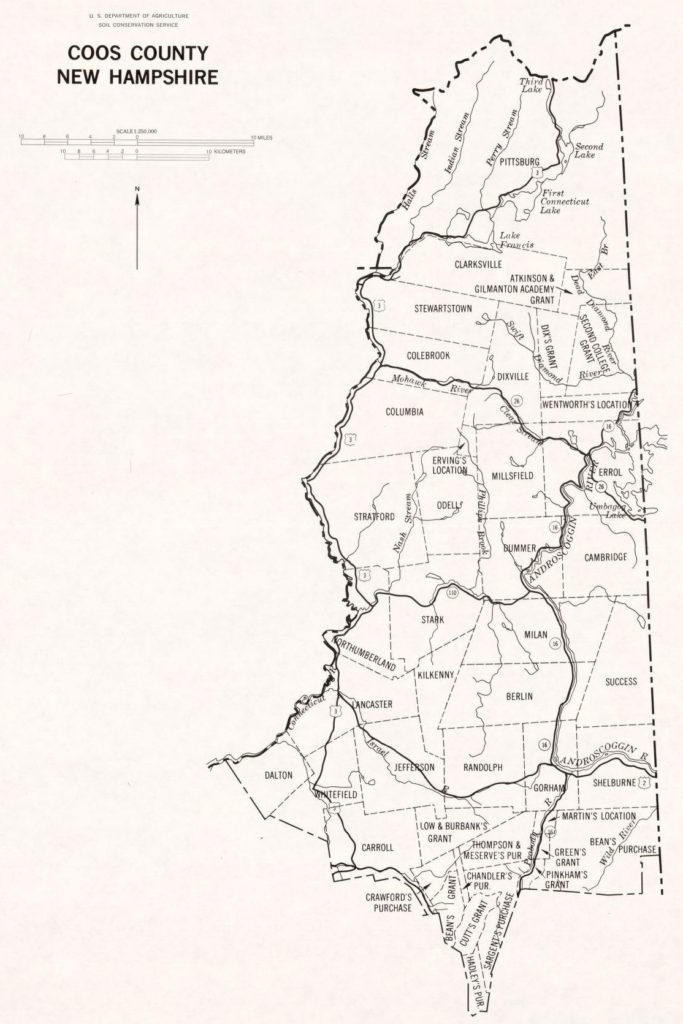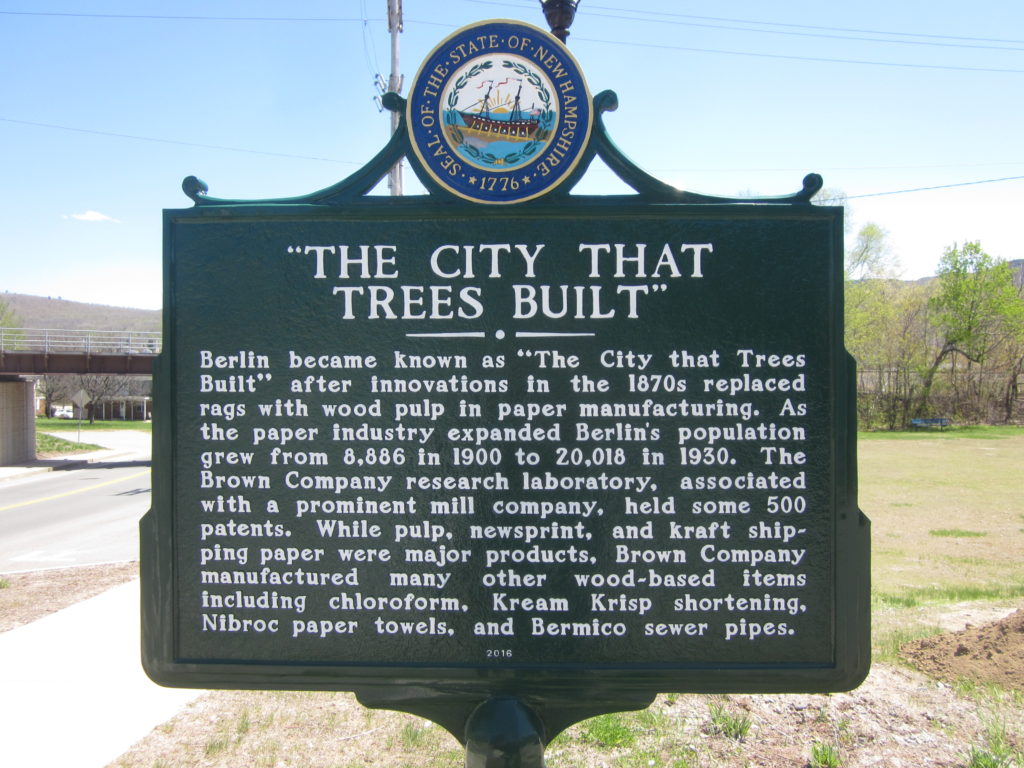The Canadian element found in Berlin a safe, reliable place to live; and every year sees new families arrive from Canada. Berlin found in the Canadian a willing, obedient, and conscientious worker. The two combined are what has made Berlin what Berlin is today.
– The Brown Bulletin, January 1927.
There is something decidedly poetic about Aroostook and Coös, something that speaks of the landscape and its first inhabitants, that we do not have in the bureaucratic county names of Clinton and Franklin—meant to impose a national idea on the land.
The history of New Hampshire’s Coos County makes for an especially interesting case study, not least for the land and resources that gave rise to one of the state’s great industrial centers. Joining the upper reaches of the Connecticut and Androscoggin rivers, northern New Hampshire was long travelled and inhabited by Abenaki bands. In areas, the terrain is quite rugged; it includes some of the highest peaks of the White Mountains. White settlers felt the pressures of the sometimes hostile environment and could feel quite isolated even on the two major rivers’ tributaries.

Settlement nevertheless occurred in these wild expanses. The early years of the white American presence in fact make for some of the most storied moments in New Hampshire history, from Ethan Allan Crawford’s trials and tribulations at his mountain notch to the short-lived Indian Stream Republic at the northern tip of the state.
Over the course of the nineteenth century, the town of Berlin emerged as the dominant economic center in the region. Although a township covering the area was granted prior to the American War of Independence, a community worthy of that name only formed in Berlin in the early 1820s; the New Hampshire legislature approved an act of incorporation in July 1829 and the first town meeting occurred on September 1. The town then had little cattle, little improved land, and little to suggest a booming future—save perhaps for a grist mill, built around this time, to which carding equipment was eventually added.
Ultimately it was the railway that most profoundly altered the economic and demographic realities of Coos County, Berlin in particular. The completion of the Atlantic and St. Lawrence Railroad in 1853 helped to further break the wilderness while connecting the region to major hubs—namely Montreal and Portland. The significance of water power did not recede entirely: it continued to move seemingly inexhaustible amounts of timber and to power local mills. But it was steam that brought rising numbers of lumberjacks and industrial workers to the region and helped to move out finished goods.
The sawmill that appeared on the Androscoggin River as early as 1852 anticipated Berlin’s ultimate vocation—a center of the lumber and pulp and paper industries. Taking advantage of outer connections, local businessmen formed the Berlin Mills Company in 1866; in 1868, the corporation was reorganized under William W. Brown. The Browns would be involved in the leadership and upper management for nearly a century. (In fact, the concern became the Brown Company when conflict erupted between the United States and Germany in 1917.)

The company expanded from sawing and lumber to pulp and paper in the 1880s. It established a world-class chemistry laboratory to support its activities. It eventually bought millions of acres of woodland in Quebec to feed the mills and notably established a plant in La Tuque, north of Trois-Rivières. It even altered the landscape of the Androscoggin to facilitate logging activities. The boom was such that when a fire destroyed the Lancaster, New Hampshire, courthouse, there was talk of moving the county seat to Berlin. In the end, the city would remain the industrial heart of Coos County rather than its administrative center.
By 1903, writes Rebecca Rule,
the ever-expanding mill complex housed a wood yard, pulp dryers, newsprint machines, and a hydroelectric plant. The mill was producing 200 tons of paper per day. To feed the hungry paper machine, scouts sought out the best softwood stands and logging camps sprang up like mushrooms on the hillsides in New Hampshire, Vermont, and northwestern Maine. In the beginning, all the trees were cut by hand and hauled or “twitched” out of the woods by horses. During spring log drives, the mass of logs filling the Androscoggin could extend five miles upriver.
The Berlin Mills Company was not the lone industrial concern in the quickly growing city. The International Paper Company consolidated holdings all across northern New England—Berlin included—at the turn of the century. But, until the 1950s, nothing could compare to the power, influence, and wealth of the Browns, Berlin’s royals. Their role was patent in all sorts of paternalistic endeavors, including the settlement house formed by Caroline Brown, a daughter of Confederate general John B. Gordon who married into the family.
By the 1870s, Berlin was on a steady ascent—both demographic and economic—that would make it one of the most important urban centers in the state. In 1880, it still lagged behind four other Coos towns in population; it hardly registered as a regional center. By contrast, by 1900, the City of Berlin, with its nearly 9,000 residents, had become the seventh largest agglomeration in the state. It helped to propel growth by which Coos outclassed three other, more southerly counties in sheer population. Canadians were an inescapable force in that process.
Next week: The making of a “Little Canada” in northern New Hampshire.

Pingback: This week’s crème de la crème — August 10, 2019 | Genealogy à la carte
I am 70 and live in Berlin all my life drove truck for 49 years all over the north east and I think Berlin is a beautiful place to live with a river run right in the middle of town and mountain all around
I first went to Berlin 8 years ago with my mother looking for family. My father was born there and several of his family members. I went to city hall and located the records. The home where he grew up was no longer standing. Stayed at a lovely hotel for a few days trying to contact other Lapointe’s or LaPointe’s if you ask my cousins in FL. The gentleman at the hall of records was so kind n helpful. Two years later I brought my sister there. We are hoping to go back in 2021. Beautiful town.
My Mother was a lapointe from Berlin. Her father was George, born 1888, died 1945.
If you have not been there yet I recommend moffet house on high street. It is a small museum of Berlin. Locally renowned, it is the place to go to learn anything and everything about Berlin nh.